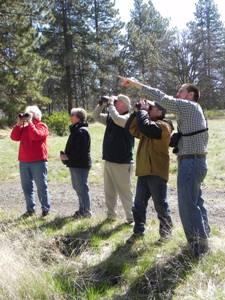Binos, Birds and Ballet in the Klamath Marsh
By Gary Lewis

"The steady, rapid, springing step, the long hair, the aquiline features and the glowing, angry eyes – the expression of a handsome man conscious of ceasing to be young and an air and manner that told you that whoever you might be he was John Audubon, will never be forgotten by anyone who knew or saw him."
Thus, one anonymous observer recalled the naturalist. Portraits made by his son, John Woodhouse Audubon, show him with his favorite double shotgun, a 10-gauge fowling piece.
"He had the advantage of being a foreigner," wrote Donald Culross Peattie in Audubon's America, "so that he took nothing for granted and... all things American struck him as fresh."
In The Birds of North America, Audubon identified 25 species and several sub-species new to science. Audubon's life work was finished in 1851, but his influence lives on in the memory of birders and fowlers.
We had both in the marsh at the end of April for a tour of the Skillet Handle and Putnam Point on Upper Klamath Lake and the Lower Klamath Refuge.
 Darrel and Diana Samuels, Dave Hewitt, Julie Van Moorhem and Mary Ellen Sargent, of Klamath Falls, members of the local chapter of the Audubon Society, were our experts. I brought along Sonny Bachman, great-great-great-grandson of one of Audubon's best friends.
Darrel and Diana Samuels, Dave Hewitt, Julie Van Moorhem and Mary Ellen Sargent, of Klamath Falls, members of the local chapter of the Audubon Society, were our experts. I brought along Sonny Bachman, great-great-great-grandson of one of Audubon's best friends.
While passing through Charleston, SC, in 1831, Audubon chanced to meet a clergyman, John Bachman. The two men, both enthusiastic hunters, formed a friendship manifest in their book The Quadrupeds of North America.
Out in the marsh, our first goal was to catch the dance of the grebes. At Putnam Point, there were four subspecies – eared, horned, Western and Clark's.
Dave Hewitt pointed out a pair of Western grebes. The male surfaced and presented a fish to his intended. They dipped their heads as if preening, then the male moved alongside the female.
"There is a very ritualistic courtship behavior that establishes that pair bond that says yes, I'm committed to you for this season. The male really has to prove his worth. Then they do this dancing thing. They take off and rush across the top of the water. The female sets the tone and the male cannot drop into the water before the female does or he is not keeping up his end. It is a long and involved process when she finally says ‘I'm going to trust you to be my mate for this season.' There are a lot of fish that have to get brought back to her while she is on the nest."
We turned to look back up the lake and saw another pair side by side. As still as swans one moment, the next they were on their toes in a headlong allegro across the surface.
Out on the Skillet Handle, a peninsula in Klamath Lake near the Running Y Ranch resort, we watched forest birds and a killdeer that feigned a broken wing to lead us away from her nest.
In Sonny Bachman and Dave Hewitt, there was a glimmer of the zeal that Audubon and John Bachman shared in their letters. Bachman, who used to host Upland Adventures TV, is an enthusiastic fowler like his grandfather. In his grandfather's memoirs, I found a letter written to John Woodhouse Audubon about a duck hunt in the late 1850s.
"I could not crawl in the mud or wade up to my waist in water, so that I took them on the wing; sometimes I tumbled over one or two fat fellows at a shot and then again only made the feathers fly. I bagged some wood-cocks and a few partridges..."
Out on a dike road in the Lower Klamath Marsh, we slowed and stopped. Rooster pheasants cackled from the ryegrass and red-winged blackbirds lit in the tules.
Under a clear blue sky, thousands of white Ross' geese gabbled and preened. A scant two months ago, we hunted these birds and smelled the decay of the swamp while snowflakes piled on our hats. Now there was new growth in the marsh, the birds rested and ready for the move north to Canada.
The ballet of the grebes intensifies in May. Mallards, cinnamon teal and northern shovelers display their spring plumage and honkers keep their little ones in tow or lose them to the hawks.
In the spring, with double-barreled optics in hand, a hunter gains a special appreciation for the quail, pheasants and waterfowl pursued in the fall.


